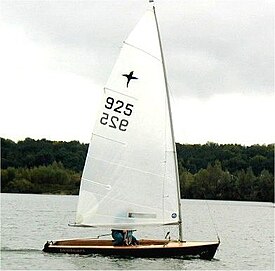Engineering:Phantom (dinghy)
 | |
| Development | |
|---|---|
| Designer | Paul Wright & Brian Taylor |
| Location | United Kingdom |
| Year | 1971 |
| No. built | 1,000 |
| Builder(s) | Butler Boats, Ovington Boats, Vander Craft |
| Role | One-design racer |
| Boat | |
| Boat weight | 134 lb (61 kg) |
| Draft | 2.80 ft (0.85 m) with the centreboard down |
| Hull | |
| Type | Monohull |
| Construction | Fibreglass, wood, composite material |
| LOA | 14.50 ft (4.42 m) |
| LWL | 13.83 ft (4.22 m) |
| Beam | 5.50 ft (1.68 m) |
| Hull appendages | |
| Keel/board type | centreboard |
| Rudder(s) | transom-mounted rudder |
| Rig | |
| Rig type | Catboat rig |
| Sails | |
| Sailplan | Catboat |
| Mainsail area | 105.00 sq ft (9.755 m2) |
| Total sail area | 105.00 sq ft (9.755 m2) |
The Phantom is a British sailing dinghy that was designed by Paul Wright and Brian Taylor as a one-design racer and first built in 1971.[1]
Production
The design was at one time built by Butler Boats and Vander Craft, both located in the United Kingdom . It is now constructed by Ovington Boats, which is also in the United Kingdom. Ovington-built boats are still sold by Vander Craft.[1][2][3][4][5][6]
The boat can also be amateur-built from plans, using the stitch and glue construction method.[7]
Design
The Phantom is a recreational sailboat, with the hull built predominantly of a fibreglass foam sandwich laminate. The hull has hard chines and a deep V-shaped bow to promote planing. It has a stayed mast, typically made from carbon fibre along with the boom. It has a catboat rig, a raked stem, a vertical transom, a transom-hung rudder controlled by a tiller and a retractable centreboard. It displaces 134 lb (61 kg).[1][6][7]
The boat has a draft of 2.80 ft (0.85 m) with the centreboard extended and 6 in (15 cm) with it retracted, allowing beaching or ground transportation on a trailer or car roof rack.[1]
Operational history
A review in Go Sail noted of the design, "with her lightweight hull and large rig on a stayed mast she has a high power to weight ratio, but is stable and responsive. There is no trapeze or spinnaker and she can carry a wide range of helm weights".[7]
See also
- List of sailing boat types
- DC‐14 Phantom - a boat with a similar name
- Phantom 14 - a lateen-rigged boat with the same name
- Phantom 14 (catamaran) - a boat with a similar name
- Phantom 16 (catamaran) - a boat with a similar name
Similar sailboats
References
- ↑ 1.0 1.1 1.2 1.3 McArthur, Bruce (2020). "Phantom sailboat". sailboatdata.com. https://sailboatdata.com/sailboat/phantom-dinghy-uk.
- ↑ McArthur, Bruce (2020). "Butler Boats". sailboatdata.com. https://sailboatdata.com/builder/butler-boats.
- ↑ McArthur, Bruce (2020). "Vander Craft (UK)". sailboatdata.com. https://sailboatdata.com/builder/vander-craft-uk.
- ↑ Vander Craft (2014). "Phantom". vandercraft.co.uk. http://www.vandercraft.co.uk/phantom/index.html.
- ↑ McArthur, Bruce (2020). "Ovington Boats Ltd.". sailboatdata.com. https://sailboatdata.com/builder/ovington-boats-ltd.
- ↑ 6.0 6.1 Ovington Boats (2013). "Phantom". ovingtonboats.com. https://www.ovingtonboats.com/shop/phantom.html.
- ↑ 7.0 7.1 7.2 Go Sail (2017). "Phantom Sailing Dinghy". go-sail.co.uk. https://www.go-sail.co.uk/phantom-sailing-dinghy/.
External links
 |

